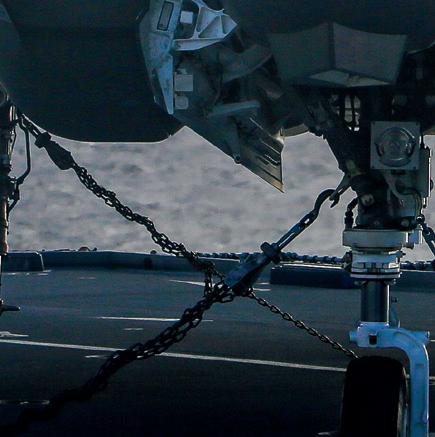
3 minute read
MCDONNELL F2H BANSHEE


Advertisement



McDonnell’s underpowered Phantom was a fundamentally sound design – so when bigger engines became available the company simply scaled it up to accommodate them, producing the F2H Banshee.









Even as the FH-1 Phantom was undergoing development during late 1944, McDonnell was preparing a larger but otherwise very similar design to take advantage of Westinghouse’s new J34-WE-22 turbojet.


Where the Phantom’s J30-WE-20 was 100in long with a diameter of 19in, the J34-WE-22 was 112in and 27in. McDonnell therefore scaled up the basic Phantom design to match. This was certainly worth doing because where the J30 produced a rather weedy 1600lb of thrust, the J34 promised a dramatic increase – 3000lb per engine.
of thrust, the J34 promised a dramatic







On March 2, 1945, just ve days before ordering 100 FH-1 Phantoms, the Navy gave McDonnell a contract for three prototypes of the scaled-up design under the designation XF2D-1. The extra power allowed the company to switch the four nose-mounted machine guns for four 20mm cannon in the same positions. The wings were larger than those of the Phantom but retained their ability to fold. The valuable experience gained from building and ying the Phantom prototypes also fed into the new development programme and McDonnell was able to make numerous changes and improvements to the aircraft’s aerodynamic shape as well as to systems, access panels and other aspects of the design. It was named ‘Banshee’ by the company.



The company was already at the point of delivering the earliest FH-1s when the rst prototype XF2H-1 ew on January 11, 1947. Following successful ight tests, the Navy ordered 56 production model F2H-1s on May 29, 1947.
The rst of these were sent to the Naval Air Test Center and subsequently to Navy units VF-171 and VF-172. No Marine units operated the F2H-1. They would, however, make good use of the next variant. Even before the rst F2H-1
McDonnell F2H-2 Banshee, WK-7, VMF-224, MCAS Cherry Point, North Carolina, 1951.
The Banshee was the rst jet operated by VMF-224. Having previously operated F4U Corsairs, it ew the F2H for only one year before transitioning to the F9F Panther in 1952.



McDonnell F2H-2 Banshee, LC-3, VMF-122, MCAS Beaufort, South Carolina, 1951.
VMF-122 had been the rst USMC squadron to operate jets with the FH-1 Phantom and also became the rst to y the new F2H Banshee in 1951.
McDonnell F2H Banshee

had been delivered, an order was placed for the signi cantly upgraded F2H-2. This featured an ejection seat – a rst for a McDonnell aircraft – wingtip tanks and four external hardpoints under each wing. Power was supplied by J34-WE34s, producing 3250lb of thrust each, performance because the F2H-2 was 1300lb heavier than the F2H-1. but this failed to translate into improved


















A further consequence of this extra weight was limited payload. The aircraft might have had eight positions for accommodate up to 1540lb of conventional tanks could only be fuelled when the wings needed to be folded on a carrier deck, the underwing stores but these could only conventional bombs or rockets in total. Also, the tip were in the down position. If the wings tanks had to be drained rst.






MCDONNELL F2H-2P BANSHEE
McDonnell F2H-2P Banshee, MW-1, VMJ-1, Pohang (K-3) Air Base, Korea, 1952.
VMJ-1 was the only USMC Banshee squadron to see combat during the Korean con ict; it operated the photo-reconnaissance variant, providing invaluable information on enemy positions.
The F2H-2 would be the mostproduced Banshee with 364 examples rolling off McDonnell’s St Louis production line. Two Marine Corps squadrons flew it – VMF122 and VMF-224 – with deliveries commencing in 1951. Both units were based at MCAS Cherry Point and both made a single deployment to the Mediterranean. In service, the Banshee was known by the affectionate nickname ‘Banjo’. With F2H-2 production under way, the Navy decided it needed some ghters capable of carrying nuclear bombs. As a result, 27 F2H-2Bs were produced with strengthened port wings, reduced cannon armament, an in ight refuelling probe installed and a new bomb rack for carrying either a Mark 7 or Mark 8 bomb – but these were own exclusively by the Navy, as were 14 F2H-2N night ghter variants tted with AN/APS-19A radars in new plastic noses.









The USMC did, however, receive the reconnaissance version – the F2H-2P. This had a much longer nose than that of the standard F2H-2 and it was divided up into three sections with room to accommodate up to six high-resolution cameras in a variety of positions.


Both Marine Photo Reconnaissance Squadron One (VMJ-1) and VMJ-2 operated the F2H-2P – with VMJ-1’s Banshees seeing combat in Korea. When it was established in late February 1952, VMJ-1 brought all Marine photo reconnaissance assets together in one




